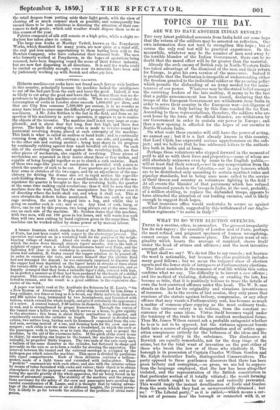A bronze fountain which stands in front of the Bibliotheque
Imperiale, at Paris, has just been coated with copper by the electrotype process. The operation was carried on in a workshop built for the purpose at the neigh- bouring village of Auteuil. About six weeks ago the upper basin, from which the water flows through sixteen tigers' mouths, was in the bath of sulphate of copper when a violent thunderstorm burst over Paris, and the lightning fell close to the workshop in question. Immediately after the storm had subsided, M. Oudry caused the copper solution to be poured oft', in order to examine the vase, and assure himself that the electric fluid had not deranged the deposit : he was extremely surprised to discover that the copper had been deposited on the tigers' heads in streaks or lines about the twenty-fifth of an inch in height, separated by equal intervals, and so happily arranged that they form a veritable tiger's skin, covered with hair, in as perfect a manner as if they had been produced by the hands of a skilful engraver. This curious effect of the electric fluid has accordingly been al- lowed to remain, and the result is a great addition to the expressive cha- racter of the work.
A paper was lately read at the Academie des Sciences by M. Lassie, " On a New System of Aerostation." The aerial ship invented by him forms a long cylinder, ten times as long as it is broad, say thirty metres in diameter, and 300 metres long, terminated by two hemispheres, and furnished with helices, which extend the whole length, and give it externally the appearance of a screw. A central tunnel, 2.50 metres in diameter, traverses it from end to end, and is strengthened by proper framework. Through the centre of the tunnel runs a hollow iron axis, which serves as a beam, to give rigidity to the structure ; this beam is about thirty centimetres in diameter, and considerably exceeds the cylinder in length. The tunnel is divided into cabins, two metres long, having each its hammock suspended from the cen- tral axis, serving instead of a car, and forming beds for the crew and pas- sengers ; each cabin is at the same time a treadwheel, in which the crew or the passengers walk in turns, so as to turn the cylinder, and so propel the machine, by the aid of the enormous helix. If the pitch of the screw is one in thirty, by marching one league in the tunnel, the machine would, theo- retically, be propelled thirty leagues. The two ends of the axis carry each a balloon of the same diameter as the cylinder, but flattened in shape and moveable on the axis so as to form a rudder for steering the apparatus. The interval between the tunnel and the external envelope is occupied by the hydrogen gas which raises the machine. This space is divided by partitions into equal compartments. Each of these divisions contains a balloon- pocket, made of a light tissue and varnished with indiarubber. These " pockets" communicate with each other, and also with the interior cabins by means of tubes furnished with cocks and valves ; their object is to obtain atmospheric air for the purpose of condensing the hydrogen gas, and so al- tering the specific gravity of the whole apparatus, the air being forced in by means of pneumatic pumps. The stability of the machine and the precau- tions necessary for the safety of the crew and passengers have received the careful consideration of M. Lassie, and it is thought that by taking advan- tage of the different currents of air at different heights, the present inven- tion is likely to go far towards the solution of the problem of aerial navi- gation.


























 Previous page
Previous page